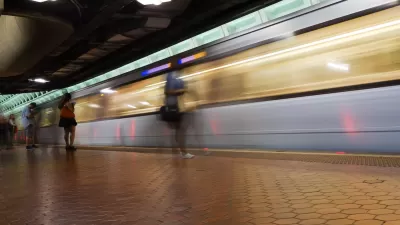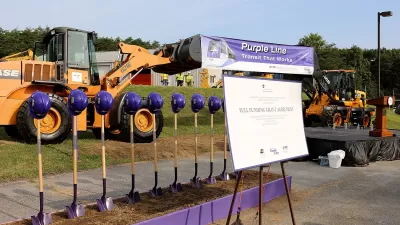Community advocates are warning that Maryland’s new light rail line could cause displacement without concerted efforts to preserve affordable housing and legacy businesses.

The Washington Post’s Katharine Shaver spoke with Gerrit Knaap, founder of the Purple Line Corridor Coalition, a group created to study the potential for displacement and other economic impacts in the areas around Maryland’s new Purple Line light rail.
Knaap spoke to the importance of preserving existing housing stock as well as boosting the construction of new mid-density housing that can serve middle-income households. “The Purple Line corridor is in for a change, and it’s really important that that change is managed to promote equitable development and that we do our best to try to prevent displacement in the corridor.” Knaap also highlighted the importance of community involvement and placemaking to maintaining a vibrant and resilient community. “Obviously being sensitive to the existing cultural assets of a community is where you start. Also engaging with residents who currently live there to identify their aspirations and their cultural preferences is key.”
In addition to housing, connecting residents to the new rail stations will require investments in safer transportation infrastructure for people biking, walking, and using other transit connections to reach the stations. Knapp notes that, due to the suburban nature of much of Maryland, “We’ve identified a lot of places along the Purple Line corridor where the pedestrian and bike access really needs quite a bit of work.”
FULL STORY: As Purple Line construction resumes, the fight against gentrification is on

Planetizen Federal Action Tracker
A weekly monitor of how Trump’s orders and actions are impacting planners and planning in America.

Congressman Proposes Bill to Rename DC Metro “Trump Train”
The Make Autorail Great Again Act would withhold federal funding to the system until the Washington Metropolitan Area Transit Authority (WMATA), rebrands as the Washington Metropolitan Authority for Greater Access (WMAGA).

DARTSpace Platform Streamlines Dallas TOD Application Process
The Dallas transit agency hopes a shorter permitting timeline will boost transit-oriented development around rail stations.

Five Key Transportation Funding Proposals in Trump’s Budget
The President’s proposed 2026 budget would keep spending roughly the same for transit and rail and eliminate over $5 billion in funding for EV charging infrastructure.

LA County Creating Action Plan to Tackle Extreme Heat
Los Angeles County is creating a Heat Action Plan to help communities stay safe during extreme heat, with steps like adding more shade, improving buildings, and supporting the neighborhoods most at risk.

Maryland Plans Quick-Build Complete Streets Projects
The state will use low-cost interventions to improve road safety in five Maryland counties.
Urban Design for Planners 1: Software Tools
This six-course series explores essential urban design concepts using open source software and equips planners with the tools they need to participate fully in the urban design process.
Planning for Universal Design
Learn the tools for implementing Universal Design in planning regulations.
City of Charlotte
Municipality of Princeton
Roanoke Valley-Alleghany Regional Commission
City of Camden Redevelopment Agency
City of Astoria
Transportation Research & Education Center (TREC) at Portland State University
US High Speed Rail Association
City of Camden Redevelopment Agency
Municipality of Princeton (NJ)





























